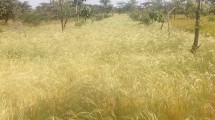Abstract
Parkia biglobosa is an important traditional economic tree legume of considerable multipurpose potentials that has not been well researched. It is used for fodder, human food, fuel wood, timber, green manure, medicine, provides shade for forage grasses and livestock and protects soil from heat and it is important in soil nutrient cycling.
The objective of this study was to determine the effect of management regimes (cutting frequency and height) on the coppicing ability, fodder production, and nutritive value potentials of cultivated Parkia trees. This initial study has shown that the tree has a potential as fodder for livestock as well as human food and should be further studiedto fully understand its biology, agronomy and feeding value under various agroforestry or silvopastoral systems of humid tropics in West Africa.
Similar content being viewed by others
References
AOAC (1980) Association Official Agricultural Chemists. Official Methods of Analysis, 13th Edition. Washington DC, USA
Arkcoll BD (1984) Some leguminous trees providing useful fruits in the north of Brazil. Pesq agropec bras, Brasilia 195s/n:235–239
Balogun AM and Fetuga BL (1986) Chemical composition of some underexploited leguminous crop seeds in Nigeria. Journal of Agriculture Food Chemistry 34(2): 189–192
Bayer W (1990) Use of native browse by Fulani cattle in Central Nigeria. Agroforestry Systems 12: 217–228
Bonkoungou EG (1987) Monograph on Nere Parkia biglobosa (Jacq) Benth, multipurpose agroforestry genus. National Centre for Scientific Research and Tecnological Research, Research Institute in Tropical Biology and Ecology, pp 45
Booth FEM and Wickens GE (1988) Non-timber uses of selected arid zone trees and shrubs in Africa. FAO Conservation Guide 19, 176 pp
Brewbaker JL (1987) Significant nitrogen fixing trees in agroforestry systems. In: Gholz HI, ed., Agroforestry: Realities, Possibilities and Potentials, pp 31–45. Martinus Nijhoff Publishers
Brewbaker JL, Halliday J and Lyman J (1984) Economically important nitrogen fixing tree species. Nitrogen fixing tree research reports 1: 35–41
Campbell-Platt G (1980) African locust-bean (Parkia species) and its West African fermented food product, dawadawa. Ecology of Food and Nutrition 9: 125–132
Cobbina J, Atta-Krah AN, Meregeni AO and Duguma B (1990) Productivity of some browse plants on acid soils of south eastern Nigeria. Tropical grasslands 24: 41–45
Dalziel JM (1937) The useful plants of West tropical Africa. Crown agents for the Colonies. London, 612 pp
Douglas JS (1972) Tree crops for food, forage and cash, parts 1 & 2. World Crops 24: 5–19, 86–89
Fagbemi T (1991) Plant growth and yield interactions under cereal-tree crop combinations in the southern Guinea Savanna Zone of Nigeria. Ph.D. thesis, (unpublished), University of Ibadan
Felker P and Bandurski RS (1979) Uses and potential ofes of leguminous trees for mineral energy input agriculture. Economic Botany 33(2): 172–184
Hopkins HC (1983) The taxonomy, reproductive biology and economic potential of Parkia (Leguminosae; Mimosoidae) in Africa and Madagascar. Botanical Journal of Linnean Society 87: 135–167
Ladipo DO, Soladoye MO and Kapoor P (1990) Conservation of the genetic resources of Parkia biglobosa (Jacq.): a multipurpose forest tree species of Nigeri a. Proceedings International symposium on the conservation of biodiversity, IITA 2–5 September 1990
Okafor JC (1980) Trees for fodd and fodder in the savannah areas of Nigeria. The International Tree Crops Journal 1: 131–141
Oyenuga VA (1968) Nigeria's food and feeding-stuffs: their chemistry and nutritive value. Ibadan University Press, 99 pp
Reed JD (1986) Relationships among soluble phenolics, insoluble proanthocyanidins and fibre in East African browse species. Journal of range management 39: 5–7
Reed JD, Horvath PJ, Allen MS and Van Soest PJ (1985) Gravimetric determination of soluble phenolics including tannins from leaves by precipitation with ytterbium. Journal of the Science of Food and Agriculture 36: 255–261
Reynolds L and Adeoye SAO (1986) Planted leguminous browse for livestock production. In: Kang BT and Reynolds L, eds, Alley farming in the Humid and Subhumid Tropics. Proceedings of an international workshop held at Ibadan, Nigeria, 10–14 March 1986. IDRC-271e, pp 44–54
Sabiiti EN (1991) Potential Parkia germplasm for evaluation. African feeds research network newsletter, ILCA 1(1): 12–8
Sabiiti EN and Cobbina J (1991) Parkia biglobosa: a multipurpose fodder tree legume in West Africa. Submitted to the International Tree Crops Journal
Steel RG and Torrie JH (1980) Principles and procedures of statistics: a biometrical approach, 2nd edition. McGraw-Hill Comk Company, 633 pp
Tilley JM and Terry RA (1963) A two stage technique for the in vitro digestion of forage crops. Journal of British Grassland Society 18: 104–111
Van Soest PJ (1965) Use of detergents in analysis of fibrous feeds. 111. Study of effects of heating and drying on yield of fibre and lignin in forages. Journal of the Association of Official Agricultural Chemists 48: 787–790
Woodward A and Reed JD (1989) The influence of polyphenolics on the nutritive value of browse: A summary of research conducted at ILCA. International Livestock Centre for Africa bulletin 35: 2–11
Author information
Authors and Affiliations
Rights and permissions
About this article
Cite this article
Sabiiti, E.N., Cobbina, J. Initial agronomic evaluation of Parkia biglobosa in the humid zone of Nigeria. Agroforest Syst 17, 271–279 (1992). https://doi.org/10.1007/BF00054152
Issue Date:
DOI: https://doi.org/10.1007/BF00054152




